方案详情文
智能文字提取功能测试中
Food Chemistry 358 (2021) 129848Contents lists available at ScienceDirectFood Chemistry Food Chemistry 358 (2021)129848Y. Xiao et al. journal homepage: www.elsevier.com/locate/foodchem The effect of Eurotium cristatum (MF800948) fermentation on the quality ofautumn green tea Yue Xiaoa,b,Maoyun Li.,, Ya Liu , Shurong Xu, Kai Zhonga,,Yanping WuabHong Gaoa,b,* College of Biomass Science and Engineering and Heathy Food Evaluation Research Center, Sichuan University, Chengdu, Sichuan 610065, ChinaKey Laboratory of Food Science and Technology of Ministry of Education of Sichuan Province, Sichuan University, Chengdu, Sichuan 610065, China ARTICLEINFO A BSTRACT Keywords:Autumn green teaEurotium cristatumQualityCatechins Autumn green tea (AT) has poor taste quality for its strong astringency. This study aims to improve the tastequality as well as the aroma of AT by Eurotium cristatum (MF800948) fermentation and to produce a fermentedautumn green tea (FT). Results showed that the aroma quality of AT was improved, and the content of terpenealcohols that impart characteristic flowery aroma to FT significantly increased. The umami intensity of FT wascomparable to that of AT while the astringency tasted much weaker mainly due to the oxidation of the catechins.The results also confirmed that theabrownins exhibited strong umami taste, not astringent taste. Finally, ametabolic map was analyzed to show the effect of E. cristatum (MF800948) on the quality of AT, and to visualizethe changes of differential compounds in AT and FT. The work provides insights into the quality improvement ofautumn green tea. 1. Introduction Green tea is a kind of non-fermented tea, which is consumedworldwide and especially popular in China and Japan. Polyphenols(especially the catechins) and free amino acids are important qualitydeterminants of green tea, as they mainly impart the astringent andumami taste to the green tea, respectively. The concentration of poly-phenols and amino acids, as well as their ratio are crucial for the tastequality of green tea (Li et al., 2016). In China, green tea is divided intospring, summer, and autumn green tea according to different growingseasons. Summer and autumn green teas have higher content of cate-chins and lower content of amino acids than spring green tea, and theyare accordingly bitterer and more astringent than spring green tea (Daiet al., 2015). Taste is one of the most important factors for consumerswhen choosing green tea. Summer and autumn green teas with inferiortaste are not favored as spring green tea, which limits their markets.Therefore, methods should be developed to improve the quality, espe-cially the taste quality, of summer and autumn green teas. Catechins, especially for (-)-epigallocatechin gallate (EGCG) and(-)-epicatechin gallate (ECG), are recognized as the major contributorsto the bitterness and astringency of green tea (Narukawa, Kimata, Noga,&Watanabe, 2010; Xu, Zhang, Chen, Wang, Du, &Yin, 2018). Moreover, the bitter and astringent intensity of green tea is positivelycorrelated with the content of catechins (Narukawa et al., 2010). In thisregard, several attempts have been made to improve the taste of autumngreen tea by reducing the content of catechins. For example, Cao et al.(2019) reported that the bitterness and astringency of autumn green teadecreased with the decreased ratio of gallated catechins after tannasetreatment of autumn tea leaves and tea infusion. Furthermore, Zhanget al. (2016) improved the sweet aftertaste and overall acceptability ofgreen tea infusion by hydrolyzing EGCG and ECG with tannase. Thesemethods reduced the bitterness and astringency of autumn green tea,and new methods should be developed to improve its overall quality,including taste and aroma quality. Eurotium cristatum is the predominant fungus found in Fuzhuan bricktea, a type of post-fermented dark tea. During fermentation, E. cristatumsecretes extracellular enzymes to promote the metabolism of chemicalcompounds in tea leaves, which affects the quality of Fuzhuan brick tea(Rui et al.,2019). When applied in the fermentation of green tea leaves,E. cristatum causes the biotransformation of phenolic compounds in tealeaves and decreases the content of catechins (Xiao, Zhong, Bai, Wu, &Gao, 2020a; Xiao, Zhong, Bai, Wu, Zhang, & Gao, 2020b). It indicatesthe potential of E. cristatum in reducing bitterness and astringency ofautumn green tea. Therefore, the strain E. cristatum (MF800948) was ( E-mail address : ga o 523@ ho t m a i l.c o m ( H. Gao). ) ( https: / /doi.or g /1 0 .1016/j.foodchem.202 1 .129848 ) ( Received 6 October 2020; Received in revised f orm 21 February 2021; Accepted 9 April 2021Available online 20 April 2021 ) applied in the fermentation of autumn green tea to study its effect on thequality of autumn green tea, particularly the taste improvement. Theresults presented in this work can provide insights into the qualityimprovement of autumn green tea. 2. Materials and methods 2.1. Materials and chemicals Autumn green tea (AT) was kindly provided by the Pingwu Xue-baoding Cha Industry Development Co. Ltd. (Sichuan, China). Fresh tealeaves (one bud with 3-4leaves) were collected from local tea gardens atan altitude of about 800 m(104.59°E, 32.10°N, Sichuan, China). Sam-ples used in the present study were processed in late August. The strainE. cristatum (Accession No. MF800948) was isolated from Pingwu Fuz-huan brick tea and identified by morphologic characteristics andphylogenetic analysis of fungal 18S rDNA sequencing (Xiao et al.,2020a). It was activated on potato dextrose agar (PDA) plate in advance,and used for fermentation. Caffeine, theobromine, theophylline, gallicacid (GA), epicatechin gallate (ECG), epigallocatechin gallate (EGCG),catechin (C), epicatechin (EC), epigallocatechin (EGC), theanine and n-alkane mixture (C6 to C24) were purchased from Sigma-Aldrich Co. (St.Louis, MO, USA). Standard solution of amino acids was purchased fromMembraPure GmbH (Hennigdorf, Brandenburg, Germany). Methanol(HPLC grade) was purchased from Kelong Chemicals Co. Ltd.(Chengdu,Sichuan, China). Ultrapure water was prepared using a Milli-Q waterpurification system (Millipore, Billerica, MA, USA). 2.2. Preparation of E. cristatum (MF800948) fermented autumn greentea Preparation of E. cristatum (MF800948) fermented autumn green tea(FT) was conducted according to a previous report (Xiao et al., 2020b).Briefly, 200 g of autumn green tea (AT) was sterilized at 121 °C for 20min. After cooling down to room temperature, tea leaves were inocu-lated with E. cristatum (MF800948) fungal suspension at 6 ×10 CFU/mL. Fermentation was conducted at 28C for 21 days at following hu-midity conditions: days 1-4 at 80% humidity; days 5-14 at 70% hu-midity; days 15-18 at 65% humidity; and days 19-21 at 45% humidity.After fermentation, the FT samples were dried at 50 °C for 48 h andstored at - 20°C for further analysis. Five fermentation repetitions wereconducted. 2.3. Aroma composition analysis The aroma was analyzed using headspace solid-phase micro-extraction (HS-SPME) coupled to GCMS-QP2010 SE (Shimadzu, Japan)(Xiao et al., 2020b). Briefly, 1.0 g of tea sample was brewed with 5 mL ofboiling water in a sealed headspace vial (20 mL) to equilibrate for 30min at 60°C. The volatile compounds were extracted with a 50 um DVB/CAR/PDMS fiber needle (Supelco, Sigma Aldrich, St. Louis, Mo.,USA)for 30 min. Thereafter, the fiber needle was immediately inserted intothe GC injector connected with a DB-5MS capillary column (30 m x0.25 mm ×0.25 um, Shimadzu, Japan) for 5 min desorption at 240°C.The oven temperature was programmed as follows: the initial temper-ature of 40 °C was held for 3 min, increased by 3°C/min to 85°C andheld for 3 min, then increased by 3 C/min to160 °C, and finallyincreased by 10 °C/min to 240°C and maintained for 5 min. Purifiedhelium (>99.999%) was used as the mobile phase flowed at 1.0 mL/min.The EI mass spectra were generated at 70 eV in a full scan mode from 35to 400 amu. The temperature of ion source was 230 °C. Identification ofvolatiles was performed by comparing their retention indices (RI) to n-alkanes (C6-C24), and mass matching to NIST14s MS data library withsimilarity degree exceeding 90%. Quantification of volatiles was per-formed by peak area normalization and calculated as a percentage of thetotal peak area. Data were then subjected to the supervised orthogonal partial least square-discriminate analysis (OPLS-DA) using SIMCA-Pversion 14.1 software (Umetrics AB, Umea, Sweden). 2.4. Profile of amino acids The extraction of amino acids was performed according to the pre-viously reported method (Xu, Song, Li, & Wan, 2012). One gram ofground sample was extracted with 20 mL of boiling water for 30 min in aboiling water bath. Tea infusions were filtrated and cooled to roomtemperature. When diluted to 20 mL with ultrapure water, tea infusionswere analyzed by an A300 automatic amino analyzer (MembraPureGmbH, Brandenburg, Germany). Data were recorded and analyzed bythe Chromatography Data Handing System software. 2.5. Quantification of gallic acid, catechins and purine alkaloids Gallic acid, catechins and pure alkaloids were extracted by sonicat-ing 1.0 g of ground sample in 20 mL of 70% (v/v) methanol solution for15 min (Xin et al., 2018). The HPLC analysis was performed using aThermo Ultimate 3000 HPLC system equipped with an Ultimate 3000diode array detector (Thermo Fisher Scientific, Waltham, MA, USA).Chromatographic separation was achieved on an Inertsil ODS-4 column(4.6 mmx 250mm x 5 um; GL-science Inc., Tokyo, Japan). Ultrapurewater-0.1% formic acid solution (eluent A) and methanol (eluent B)were used as the mobile phases flowed at a rate of 0.8 mL/min. Thegradient elution was programmed as follows: 5-22% B at 0-5 min; 22%B at 5-20 min; 22-24% B at 20-35 min; 24-25% B at 35-45 min;25-40% B at 45-50 min; and 40-45% B at 50-60 min. The columntemperature was kept constant at 30°C, and the injection volume was10 pL. The instrument control, data acquisition and data analysis wereconducted using Chromeleon Chromatography Data System software. 2.6. Determination of total polyphenols, flavonoids, water-solublecarbohydrates and tea pigments The Folin-Ciocalteu method was used to determine the polyphenols(Velioglu, Mazza, Gao, & Oomah, 1998), and the content was presentedas GA equivalent (mg GA/g tea). The aluminum trichloride colorimetricmethod was used to determine the content of flavonoids, which waspresented as rutin equivalent (mg rutin/g tea) (Ordonez, Gomez, Vat-tuone,& Isla, 2006).The phenol-sulfuric acid method was used in thedetermination of carbohydrates, and the result was presented as glucoseequivalent (mg glucose/g tea) (Albalasmeh, Berhe,& Ghezzehei,2013).Tea pigments, including theaflavins, thearubigins and theabrownins,were analyzed with the system analysis method as described previously(Huang, Xiao, Cong,Wu, Huang, & Yao, 2016). 2.7. Taste characteristics of tea infusion and theabrownins Taste evaluation was performed with an E-tongue sensor system TS-5000Z (Insent Inc., Fukuoka, Japan). The TS-5000Z comprises six lipidmembrane sensors for detection of bitterness (SB2C00), astringency(SB2AE1), sourness (SB2CA0), sweetness (SB2GL1), saltiness (SB2CTO),and gustatory stimuli umami (SB2AAE). For taste evaluation of teainfusion, sample was prepared according to the national standard GB/T23776-2009 (Xu, Wang, & Zhu, 2019). The theabrownins were pre-pared at concentrations of 0.6, 1.8, 3.6, and 7.2 mg/mL based on itscontent in FT infusion (0.6 mg/mL). In each measurement, 80 mL of teainfusion or theabrownins solution was poured into a 120-mLbeaker, inwhich the sample was continuously detected for 120 s at 25°C, followedthe detection of the sample aftertaste for another 30 s. Each samplesolution was measured 4 times, and the most stable 3 data points wereselected for further analysis. (A) (C) (B) (D) Data were expressed as means ± standard deviations (n = 3 for AT,and n= 5 for FT).Significant differences were analyzed by student’s t-test using SPSS version 22.0 software (SPSS Inc., Chicago,IL, USA). Datawere pretreated with the Z-score method when submitted to the OPLS-DA and hierarchical cluster analysis (HCA). The OPLS-DA was per-formed with the SIMCA-P version 14.1 software (Umetrics AB, Umea, Fig. 1. Analysis of volatile compounds. (A) Total ion chromatogram; (B) Relative abundance of different types of volatiles; (C-D) Results of OPLS-DA analysis, R’x=0.953, R’Y=0.999,Q=0.993. AT, autumn green tea; FT, E. cristatum (MF800948) fermented autumn green tea. 2.8. Data analysis and statistics Sweden). The HCA was achieved by the R (version 4.0.2). The variableimportance projection (VIP) values of metabolites were calculated, andthe metabolites with VIP exceeding 1.0 and p-values below 0.05 wereselected as biomarkers in the pathway analysis. The pathway analysiswas carried out on the MetaboAnalyst website following a previousreport (Chong, Wishart, & Xia, 2019). A visualized integration metabolicmap of the main metabolic pathways and related metabolites was pre-sented based on the Kyoto Encyclopedia of Genes and Genomes (KEGG) database (https://www.kegg.jp/kegg/pathway.html). 3. Results and discussion 3.1. Aroma characteristics of E. cristatum (MF800948) fermentedautumn green tea As shown in Fig. 1, volatiles changed significantly after E. cristatum(MF800948) fermentation. The levels of 87 identified volatiles werepresented in Supplementary Table S1 in detail. Alcohols were the mostabundant in both AT and FT, accounted for 40.11% and 76.17%,respectively (Fig. 1B). Linalool (8.67%), (Z)-geraniol (5.84%), 1-octen-3-ol (3.53%) and hotrienol (3.35%) were the main alcohols in AT,while (Z)-linalool oxide (32.82%), linalool (17.32%), (E)-linalool oxide(furanoid) (9.87%) and 1-octen-3-ol (3.06%) were the main alcohols inFT. Aldehydes in AT accounted for 24.96%, mainly consisted of hexanal(4.74%), nonanal (4.19%), benzaldehyde (3.55%) and (E,E)-2,4-hep-tadienal (2.80%). The content of aldehydes in FT was 8.19%, which waslower compared to that in AT. The content of ketones, esters, and hy-drocarbons in FT were also lower than those in AT, and were all at arelatively low level in FT. The OPLS-DA score scatter plot showed that FT and AT samples wereclearly separated from one another (Fig. 1C). Based on the loadingscatter plot (Fig. 1D) and VIP values of volatiles (Table S1), 22 volatilesmainly contributed to the variation. Some of the contributors were (Z)-Linalool oxide, (E)-Linalool oxide (furanoid), linalool, (Z)-geraniol,hexanal and nonanal. High content of (Z)-linalool oxide, linalool, and(E)-linalool oxide (furanoid) in FT endowed FT with characteristicflowery aroma. Alcohols, especially for linalool oxides, have also beenfound to be abundant in other post-fermented dark teas, such as Pu-erhteas and Fuzhuan brick teas (Cao et al., 2018; Lv, Wu, Li, Xu, Liu, &Meng, 2014); however, their contents were less than those observed inFT. It indicates that E. cristatum (MF800948) could promote the meta-bolism of terpene alcohols (flowery aroma) in autumn green teafermentation. The fungal/flower aroma is the unique aroma of high-quality post-fermented dark tea (Xu, Mo, Yan, & Zhu, 2007). In thisregard, the aroma quality of autumn green tea was improved afterE. cristatum (MF800948) fermentation. 3.2. Effect ofE. cristatum (MF800948) on the chemical compositions ofautumn green tea As shown in Fig. 2, contents of amino acids, catechins, alkaloids,polyphenols, flavonoids, carbohydrates, and tea pigments in AT weresignificantly changed after fermentation. A total of 21 amino acids,including 8 essential amino acids, 11 non-essential amino acids and 2non-protein amino acids, were detected in the tea samples (Fig. 2A); andtheir contents were shown in Supplementary Table S2. Total content ofamino acids dramatically dropped from 11.65 mg/g in AT to 0.97 mg/gin FT, which is consistent with the previous report on dark tea in whichthe total content of amino acid significantly decreased after fermentation (Zhu et al., 2016). As shown in Fig. 2B and 2C, amino acidswith different tastes were decreased; their proportions, however,showed different variation trends. Thea and GABA contribute to themouth-drying and velvety-like astringency of tea (Scharbert & Hof-mann, 2005), of which the content decreased from 4.98 mg/g(42.74%)in AT to 167.69 ug/; (17.27%) in FT. The contents of umami-tasteamino acids Asp and Glu (Kaneko, Kumazawa, Masuda, Henze, & Hof-mann, 2006; Scharbert et al., 2005) also dropped significantly from 3.75mg/g(32.15%) in AT to 169.46 pg/g (17.51%) in FT. The bitter-tasteamino acids (Val, Ile, Leu, Phe, Trp and Tyr) and sweet-taste aminoacids (Orn, Thr, Ser, Gly, Ala, and Pro) also decreased significantly afterfermentation. However, an increasement was observed in their relativeproportions. These changes greatly affected the taste of autumn greentea. The significant decrease of amino acids in FT is probably related tothe Maillard reaction and the fungal metabolism during E. cristatumfermentation (Zhu et al., 2016). Here it indicates that amino acids withlow content are not the main contributors to the taste of FT. Polyphenols, especially for catechins, are key taste compounds forbitterness and astringency (Narukawa et al., 2010; Xu et al., 2018).Totalcontent of catechins significantly dropped from 118.35 mg/g in AT to10.58 mg/g in FT (Fig. 2D). The contents of EGCG, EGC, ECG and EC inAT, which were 47.48, 36.01, 21.49 and 11.21 mg/g, respectively,decreased to 0.37, 4.99,0.40, and 1.14 mg/g, respectively, in FT.However, the content of C in AT, which was 2.16 mg/g, increased to3.68 mg/g in FT. In general, hydrolysis of gallated catechins can producenon-gallated catechins and gallic acid (GA). A significant decrease inGA, EC, and EGC showed their further metabolism during fermentation.Content of catechins and GA in tea leaves has also been reported tosignificantly decrease after fermentation with Aspergillus niger (Acces-sion No. EU314996) and A. fumigatu (Accession No. FJ844610)(Qin, Li,Tu, Ma, & Zhang, 2012). The reduction of catechins in AT might reducethe bitterness and astringency of AT. As shown in Fig. 2E, polyphenolsand flavonoids in FT also decreased after fermentation. Moreover, thecontent of water-soluble carbohydrates was changed from 70.14 mg/gin AT to 42.63 mg/g in FT. The contents of theaflavins, thearubigins, and theabrownins wereshown in Fig. 2F. Theaflavins and thearubigins in AT significantlydropped, whereas the content of theabrownins greatly increased, from15.52 mg/g in AT to 30.49 mg/g in FT. Theabrownins are polymericcompounds, and are reported to be generated from polymerization,condensation, coupling and oxidation of catechins, theaflavins, andthearubigins with other compounds (Wang, Gong, Chisti, & SSir-isansaneeyakul, 2015). The reduction of catechins, theaflavins, andthearubigins in AT is probably related to the increase of theabrownins inFT. The peroxidase and laccases produced by microbes are closelyresponsible for the biotransformation of theabrownins, as they couldcontinuously transform tea polyphenols to theaflavins, thearubigins,and further to theabrownins (Li, Feng, Luo, Yao, Zhang, & Zhang, 2018).The Aspergillus, Rasamsonia, Lichtheimia, and Debaryomyces can produceperoxidase and laccases during the fermentation of Pu-erh tea, andcontribute to the production of theabrownins (Li et al.,2018). AT ·FT (C) |2 1.5 1 0.5 0 -0.5 -1 -1.5 Fig. 4. Comparison of autumn green tea (AT) and E. cristatum (MF800948) fermented autumn green tea (FT). (A-B) Results of OPLS-DA analysis,Rx=0.908,R’Y=1, Q²=0.998; (C) Results of HCA analysis. Thea, L-theanine; GABA, y-aminobutyric acid; AAs, amino acids; S-hydrocarbons, saturated hydrocarbons; U-hydro-carbons, unsaturated hydrocarbons. Furthermore, Aspergillus spp. (e.g. A. niger, A. tamarii and A. fumigatus)are reported to produce glycoside hydrolases, glycosyltransferases,tannase, laccase, vanillyl-alcohol oxidases and benzoquinone reductaseduring dark tea fermentation. These enzymes catalyze the hydrolysis,oxidization, conversion, and biodegradation of phenolic compounds,causing the increased theabrownins level (Ma et al., 2020). Additionally,increased content of theabrownins also caused the tea infusion topossess more brownish-red color. Similarly, tea infusion of AT wasyellowish green, while tea infusion of FT became brownish-red colorafter fermentation (Supplementary Fig. S1). Taken together, FT has similar characteristics to those of dark teas, such as Pu-erh tea andFuzhuan brick tea. It suggests that the autumn green tea can be utilizedto produce high-quality darkteaby E.E.Ccristatum (MF800948)fermentation. As shown in Fig. 2G, AT and FT were low in theophylline andtheobromine. By contrast, the content of caffeine with bitter taste wasmuch higher; however, it significantly decreased from 13.56 mg/g in ATto 10.48 mg/g in FT. This is consistent with a previous report whichshowed that A. niger could lower the level of caffeine in tea (Qin et al.,2012). Moreover, total content of these three alkaloids in FT decreased, and such decrease, especially for the decrease of caffeine, might reducethe bitterness of AT. 3.3. Taste improvement of autumn green tea and relationship betweentaste and chemical compositions The human tongue can generally recognize the difference betweentastes when the taste intensities are different by 20%; thus, the 20%change is used as a unit of the E-tongue determination. As shown inFig. 3A, sourness was not detected in both AT and FT, of which the tasteintensities were below 0. The intensities of bitterness, aftertaste ofbitterness, and saltiness of FT were slightly higher than those of AT andwere all at relatively low levels. The sweetness of AT was slightly higherthan that of FT, which might be due to the reduced content of carbo-hydrates in FT as the sweetness is mainly associated with carbohydrates(Zhang et al., 2020). It is worth noting that the intensities of astringencyand astringent aftertaste of AT was significantly reduced after fermen-tation (p <0.0001). As astringency of green tea is primarily from theEGCG, ECG, EGC, and EC (Xu et al., 2018), the reduction of astringencyof AT is suggested to be attributed to the decreased catechins. The in-tensities of umami and richness of AT and FT were comparable. Sinceapproximately 70% of the umami taste of green tea infusion is caused byfree amino acids (Zhu et al., 2020), there are other compounds thatimpart the strong umami taste of FT. Herein, we hypothesized the the-abrownins, of which the content increased in FT, might be the com-pounds mainly contributing to the taste of FT. The taste characteristics of theabrownins were shown in Fig. 3B, andthis is the first report on such data. Sourness, sweetness, and astringencywere not detected in theabrownins solutions at different concentrations,as indicated by their intensities of below 0. The intensities of bitterness,aftertaste of astringency, umami, richness, and saltiness increased withincreasing concentration of theabrownins. The intensities of aftertaste ofastringency were low, as the maximum intensity at 7.2 mg/mL was only0.63. However, theabrownins exhibited strong umami taste, whichcontributed to the umami taste of FT. The theabrownins at 0.6 mg/mLwas comparable to the concentration of theabrownins in FT infusionprepared for the E-tongue determination. Compared with the thea-brownins at 0.6 mg/mL and FT infusion, intensities of bitterness,aftertaste of bitterness, aftertaste of astrigency, umami, richness, andsaltiness were higher in FT infusion. This might be due to the coactionsof theabrownins with other compounds in FT infusion, and/or the tasteenhancement of theabrownins by other compounds. Generally, astringency and aftertaste of astringency of AT wassignificantly reduced by E. cristatum (MF800948) fermentation. Mean-while, the fermentation did not affect the umami and richness taste ofAT. The taste quality of AT was improved after E. cristatum (MF800948)fermentation, for that FT has low astringency but high intensities ofumami and richness. The taste characteristics of FT was closely relatedto the theabrownins with strong umami taste (not astringent taste).However, further research is required to study the taste interactionsbetween theabrownins and other compounds in tea. 3.4. Effect of E. cristatum (MF800948) on the biotransformation ofautumn green tea The Z-scored data for OPLS-DA and HCA were in SupplementaryTable S3. As shown in Fig. 4A, the AT samples were clearly separatedfrom the FT samples by the principal component 1 (PC1). According tothe OPLS-DA loading scatter plot (Fig.4B) and the VIP values (Table S3),a total of 88 metabolites (p <0.05) were identified as markers respon-sible for the differentiation of AT and FT. A heatmap derived from theHCA analysis displayed the dynamic changes of AT after E. cristatum(MF800948) fermentation (Fig. 4C). Each column represents a teasample, and each row represents a metabolite. The color scale from blueto red indicates the varying content of a metabolite from low to high.Based on the data, the samples were divided into two groups, the AT Fig. 5. Pathway analysis showing the effect of E. cristatum (MF800948)fermentation on the autumn green tea. group and the FT group, which is consistent with the OPLS-DA results.The contents of most compounds in AT, except for C, theophylline,theabrownins, alcohols and Ala, were decreased after fermentation. The differential compounds selected by the OPLS-DA for metabolicpathway analysis were listed in Table S4. The result of pathway analysiswas presented as a bubble plot (Fig.5). Each bubble in the bubble plotrepresents a metabolic pathway, and the bubble size indicates thepathway impact value obtained from the topology analysis and is cor-responded to the abscissa values of“Pathway Impact”. In addition, thecolor of the bubble indicates the p-value calculated from the pathwayenrichment analysis and is represented as the negative logarithm (log1o)of the p-value: the darker the color, the smaller the p-value and the moresignificant the pathway in the enrichment. The detailed results from thepathway analysis were provided in Table S4. The highly enrichedmetabolic pathways of the differential compounds included: aminoacyl-tRNA biosynthesis; alanine, aspartate and glutamate metabolism;glycine, serine and threonine metabolism; arginine biosynthesis; andbutanoate metabolism. Some other enriched pathways were methanemetabolism; arginine and proline metabolism; glyoxylate and dicar-boxylate metabolism; and cysteine and methionine metabolism. Thesemetabolic pathways are mainly associated with amino acid metabolism,as well as the metabolism of other related compounds, such as fatty acidsdegradation, monoterpenoid biosynthesis and flavonoid biosynthesis. Purine metabolism Caffeine metabolism Glycine, serine and threonine metabolism Starch and sucrose metabolism Cysteine and methionine metabolismPhenylalanine, tyrosine and tryptophan biosynthesisPhenylpropanoid biosynthesis a-D-Glucose-1P -Succinate semialdehyde intermediates (Zhu et al., 2020). The metabolic process can be inducedby both the microbial fermentation and by the treatment with microbialextracellular enzymes, such as polyphenol oxidase (PPO), peroxidase(POD), pectinase,cellulase, and laccase (Wang et al., 2015; Wang, Gong,Chisti, & Sirisansaneeyakul, 2016).However, further researches shouldbe conducted to elucidate the formation mechanisms of theabrownins.On the whole, amino acids and catechins were greatly metabolizedduring fermentation, which was closely associated with the changes ofother compounds. Such changes contributed to the quality improvementof AT by increasing contents of theabrownins and alcohols in FT. 4. Conclusions In summary, this study revealed that the quality of autumn green tea(AT) was improved by E. cristatum (MF800948) fermentation. TheE. cristatum (MF800948) fermented autumn green tea (FT) not only hadincreased flowery aroma, but also had less astringency. The improvedaroma quality was associated with the increased contents of terpenealcohols with flowery aroma, such as linalool and linalool oxides. Thereduced astringency was mainly due to the decreased contents of poly-phenols (especially for the catechins) and increased content of thea-brownins in FT. This study also reported the taste characteristics oftheabrownins, confirming that theabrownins had strong umami tastewithout astringency. The aminoacyl-tRNA biosynthesis; alanine, aspar-tate and glutamate metabolism; glycine, serine and threonine meta-bolism; arginine biosynthesis; and butanoate metabolism were closelyrelated to the fermentation of AT. The study demonstrated thatE. cristatum (MF800948) had beneficial effect on the quality of autumngreen tea, providing insights into the utilization of autumn green tea.Nevertheless, further research should be carried out to identify thechanges of other metabolites during fermentation, as well as their cor-relations with theabrownins. CRediT authorship contribution statement Yue Xiao:.: Conceptualization, Methodology, Software, Formalanalysis, Writing-original draft. Maoyun Li: Investigation, Software,Data curation. Ya Liu: Formal analysis, Investigation. Shurong Xu:Formal analysis, Data curation. Kai Zhong: Methodology, Validation,Writing- review & editing. Yanping Wu: Methodology, Resources,Writing-review & editing. Hong Gao: Conceptualization, Resources,Supervision, Funding acquisition, Writing-review & editing. Declaration of Competing Interest The authors declare that they have no known competing financialinterests or personal relationships that could have appeared to influencethe work reported in this paper. Acknowledgements This work was supported by funds of science and technology planproject of Sichuan province of China (No. 20ZDYF3186). Appendix A. Supplementary data Supplementary data to this article can be found online at https://doi.org/10.1016/j.foodchem.2021.129848. References Albalasmeh, A. A., Berhe, A. A., & Ghezzehei, T. A. (2013). A new method for rapiddetermination of carbohydrate and total carbon concentrations using UVspectrophotometry. Carbohydrate Polymers, 97(2), 253-261. Cao, L., Guo, X., Liu, G., Song, Y., Ho, C. T., Hou, R., et al. (2018). A comparative analysisfor the volatile compounds of various Chinese dark teas using combinatorymetabolomics and fungal solid-state fermentation. Journal of Food and Drug Analysis,26(1),112-123. Cao, Q.Q., Zou, C., Zhang, Y. H., Du, Q. Z., Yin, J. F., Shi, J., et al. (2019). Improving thetaste of autumn green tea with tannase. Food Chemistry, 277, 432-437. Chong, J., Wishart, D. S., & Xia, J. (2019). Using MetaboAnalyst 4.0 for comprehensiveand integrative metabolomics data analysis. Current Protocols in Bioinformatics, 68(es1), Article e86. Dai, W.,Qi, D., Yang,T., Lv, H., Guo, L., Zhang, Y., et al.(2015). Nontargeted analysisusing ultraperformance liquid chromatography-quadrupole time-of-flight massspectrometry uncovers the effects of harvest season on the metabolites and tastequality of tea (Camellia sinensis L.). Journal ofAgricultural and Food Chemistry,63(44),9869-9878. Huang, Y., Xiao, X., Cong, L., Wu, M., Huang, Y., & Yao, Y. (2016). A fermented tea withhigh levels of gallic acid processed by anaerobic solid-state fermentation.LWT-FoodScience and Technology, 71, 260-267. Kaneko, S., Kumazawa, K.,Masuda, H., Henze, A., & Hofmann, T.(2006).Molecular andsensory studies on the umami taste of Japanese green tea. Journal of Agricultural andFood Chemistry,54(7), 2688-2694. Li, Z., Feng, C., Luo, X.,Yao, H., Zhang, D., & Zhang, T. (2018). Revealing the influenceof microbiota oonj the quality of Pu-erh tea during fermentation process by shotgunmetagenomic and metabolomic analysis. Food Microbiology, 76, 405-415. Lv, S.,Wu, Y., Li, C.,Xu, Y., Liu, L., & Meng, Q. (2014).Comparative analysis of Pu-erhand Fuzhuan teas by fully automatic headspace solid-phase microextraction coupledwith gas chromatography-mass spectrometry and chemometric methods. Journal ofAgricultural and Food Chemistry, 62(8), 1810-1818. Ma, Y., Ling, T. J., Su, X. Q., Jiang, B., Nian, B., Chen, L. J., et al.(2020). Integratedproteomics and metabolomicsm janalysis of tea leaves fermented by Aspergillus niger,Aspergillus tamarii and Aspergillus fumigatus. Food Chemistry, 334, Article 127560. Narukawa, M., Kimata, H., Noga, C., & Watanabe, T. (2010). Taste characterisation ofgreen tea catechins. International Journal of Food Science and Technology, 45(8),1579-1585. Ordonez, A. A. L., Gomez, J. D., Vattuone, M. A., & Isla, M. I. (2006). Antioxidant ( a c t i v i ties of Sechium e dule ( J a c q . ) S wartz e x t ra c t s . F ood C h e mistry, 9 7 (3 ) , 45 2 -4 58 . Q in, J. - H ., L i, N . , T u , P .- F . , M a , Z . - Z . , & Zh a n g , L . ( 2012) . C ha ng e in Te a P o l y p h enol a nd ) Purine Alkaloid Composition during Solid-State Fungal Fermentation ofPostfermented Tea. Journal of Agricultural and Food Chemistry, 60(5),1213-1217. Rui, Y., Wan, P., Chen, G., Xie,M., Sun, Y., Zeng, X.,et al. (2019). Analysis of bacterialand fungal communities by Illumina MiSeq platforms and characterization ofAspergillus cristatus in Fuzhuan brick tea. LWT-Food Science and Technology, 110,168-174. Scharbert, S.,& Hofmann, T. (2005). Molecular definition of black tea taste by means ofquantitative studies, taste reconstitution, and omission experiments. Journal ofAgricultural and Food Chemistry, 53(13), 5377-5384. Velioglu, Y. S., Mazza, G., Gao, L.,& Oomah, B. D. (1998). Antioxidant activity and totalphenolics in selected fruits, vegetables, and grain products. Journal of Agriculturaland Food Chemistry, 46(10), 4113-4117. Wang, Q., Gong, J., Chisti, Y., & Sirisansaneeyakul,S.(2015). Fungal isolates from a Pu-Erh type tea fermentation and their ability to convert tea polyphenols totheabrownins. Journal of Food Science, 80(4), M809-M817. Wang, Q., Gong, J., Chisti, Y., & Sirisansaneeyakul, S.(2016). Production oftheabrownins using a crude fungal enzyme concentrate. Journal of Biotechnology,231,250-259. Xiao, Y., Zhong, K., Bai, J.-R., Wu, Y.-P., & Gao, H. (2020). Insight into effects of isolatedEurotium cristatum from Pingwu Fuzhuan brick tea on the fermentation process andquality characteristics of Fuzhuan brick tea. Journal of the science of food andagriculture, 100(9), 3598-3607. Xiao,Y., Zhong, K., Bai, J.-R., Wu, Y.-P., Zhang, J.-Q., &Gao, H.(2020). The biochemicalcharacteristics of a novel fermented loose tea by Eurotium cristatum (MF800948) andits hypolipidemic activity in a zebrafish model. LWT-Food Science and Technology,117, Article 108629. Xin, Z., Ma, S., Ren, D.,Liu, W., Han, B., Zhang, Y., et al. (2018). UPLC-Orbitrap-MS/MScombined with chemometrics establishes variations in chemical components ingreen tea from Yunnan and Hunan origins. Food Chemistry, 266, 534-544. Xu, M., Wang, J., & Zhu, L. (2019). The qualitative and quantitative assessment of teapoquality based on E-nose, E-tongue and E-eye combined with chemometrics. FoodChemistry, 289,482-489. Xu, W., Song, Q., Li, D., & Wan, X. (2012). Discrimination of the production season ofChinese green tea by chemical analysis in combination with supervised patternrecognition. Journal of Agricultural and Food Chemistry, 60(28), 7064-7070. Xu, X., Mo, H., Yan, M., & Zhu, Y. (2007). Analysis of characteristic aroma of fungalfermented Fuzhuan brick-tea by gas chromatography/mass spectrophotometry.Journal of the science of food and agriculture, 87(8),1502-1504. Xu, Y. Q., Zhang, Y. N., Chen, J. X.,Wang, F., Du, Q. Z., & Yin, J. F. (2018). Quantitativeanalyses of the bitterness and astringency of catechins from green tea. FoodChemistry, 258, 16-24. Zhang,L., Cao, Q.-Q., Granato, D., Xu, Y.-Q., & Ho, C.-T. (2020). Association betweenchemistry and taste of tea: A review. Trends in Food Science & Technology, 101,139-149. Zhang, Y. N., Yin, J. F., Chen, J. X., Wang,F., Du, Q. Z., Jiang, Y. W.,et al. (2016).Improving the sweet aftertaste of green tea infusion with tannase. Food Chemistry,192,470-476. Zhu, M.Z., Li, N., Zhou, F., Ouyang,J., Lu, D. M., Xu, W., et al. (2020). Microbialbioconversion of the chemical components in dark tea. Food Chemistry,312, Article126043. Zhu, Y., Luo, Y., Wang, P., Zhao, M., Li, L., Hu, X., et al. (2016). Simultaneousdetermination of free amino acids in Pu-erh tea and their changes duringfermentation. Food Chemistry, 194, 643-649. Zhuang, J., Dai, X., Zhu, M., Zhang, S., Dai, Q., Jiang, X., et al. (2020). Evaluation ofastringent taste of green tea through mass spectrometry-based targeted metabolicprofiling of polyphenols. Food Chemistry, 305, Article 125507. 本研究旨在利用冠突散囊菌(Eurotium cristatum, MF800948)发酵改善秋青茶的口感品质和香气,生产秋青发酵茶。结果表明,紫花苜蓿的香气质量得到改善,赋予紫花苜蓿特有香气的萜烯醇含量明显增加。FT的鲜味强度与AT相当,而涩味则弱得多,主要是由于儿茶素的氧化作用。结果还证实,茶蛋白表现出强烈的鲜味,而不是涩味。最后,通过代谢图谱分析,揭示了冠叶提取物(MF800948)对秋青品质的影响,并直观地反映了冠叶提取物和秋青中差异化合物的变化,为秋青品质的改善提供了理论依据。检测仪器:日本INSENT电子舌
关闭-
1/8
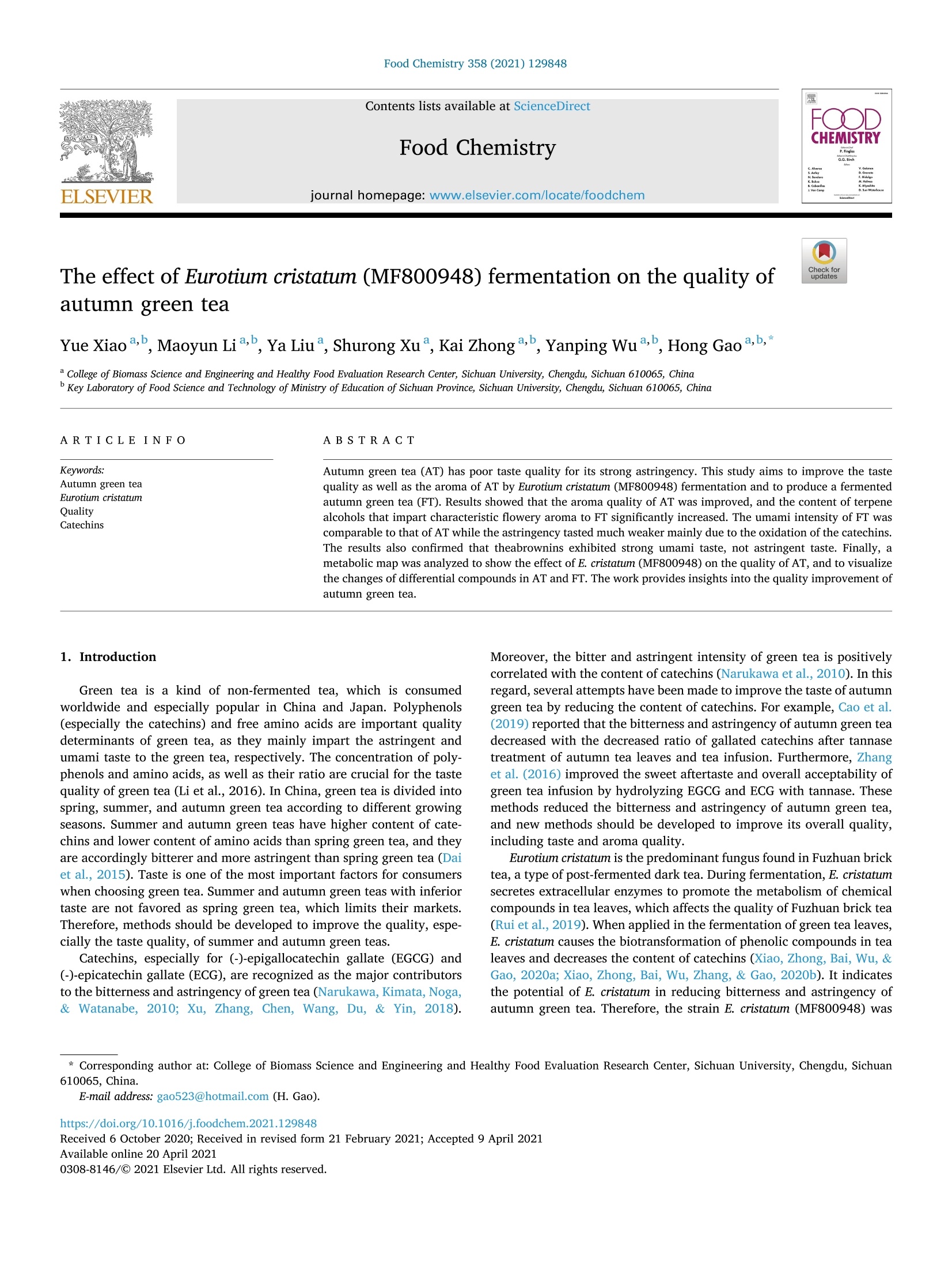
-
2/8

还剩6页未读,是否继续阅读?
继续免费阅读全文产品配置单
北京盈盛恒泰科技有限责任公司为您提供《绿茶中品质影响检测方案(感官智能分析)》,该方案主要用于茶叶中营养成分检测,参考标准《暂无》,《绿茶中品质影响检测方案(感官智能分析)》用到的仪器有电子舌、日本INSENT味觉分析系统(电子舌)。
我要纠错
推荐专场
感官智能分析系统(电子鼻/电子舌)
更多相关方案


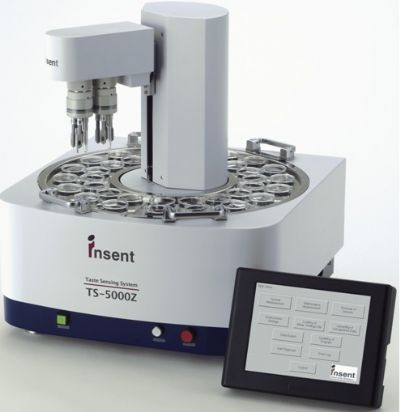
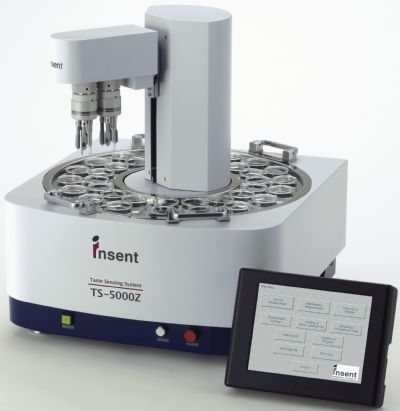
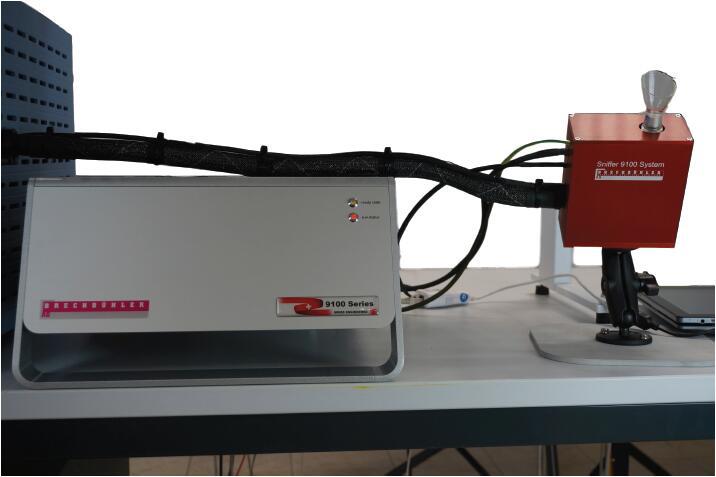
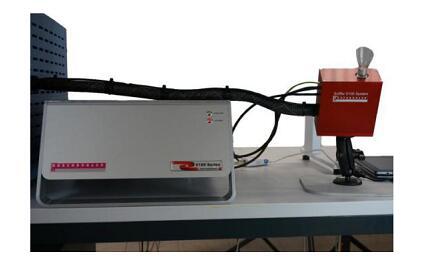
 咨询
咨询